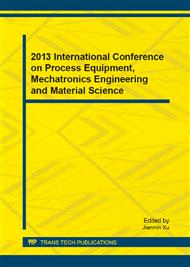p.195
p.200
p.205
p.211
p.216
p.222
p.227
p.231
p.236
Research on Energy-Saving Technology for Salt Solution Heat Pump Evaporators
Abstract:
Aiming at increasing the energy-saving efficiency of salt solution evaporation, the effect of several factors on heat pump energy-saving efficiency is studied through theoretical analyses and calculation. The factors include boiling point elevation caused by solution static pressure, superheat loss of surface evaporation, temperature difference loss caused by fouling. The conclusions are that falling-film evaporator helps improve heat pump evaporation energy-saving the most and forms the fluctuating flow of the falling film which can be used to remove fouling automatically. The Φ38mm×2mm single-tube dynamics experiment results show that the flow can produce stable 3D vibration of the cleaning spiral when the nominal flow velocity is more than 0.25m/s. The axial reciprocating motion distance is longer than one spiral pitch and reciprocating periodicity is 3-6 seconds. The sodium carbonate solution fouling removal experiment results show that the salt fouling decreases the overall heat transfer coefficient by 30% in one hour when there is no the 3D vibrating spiral-insert; and the insert can enhance heat transfer by 59% comparing to that during stable operation without this technology. Key Words: Falling-film Evaporator, Heat Pump Evaporate, Energy saving, Automatic cleaning, Heat transfer
Info:
Periodical:
Pages:
216-221
Citation:
Online since:
July 2013
Authors:
Price:
Сopyright:
© 2013 Trans Tech Publications Ltd. All Rights Reserved
Share:
Citation:


